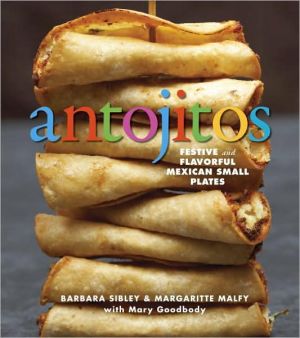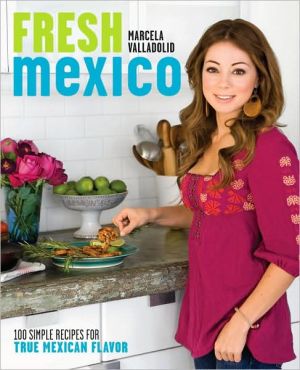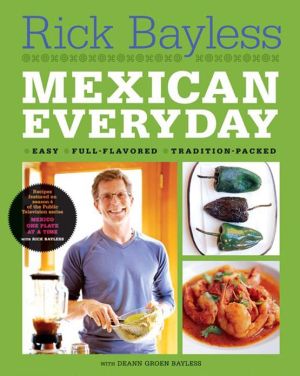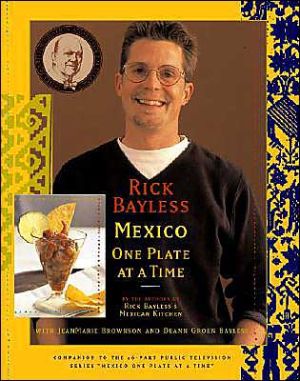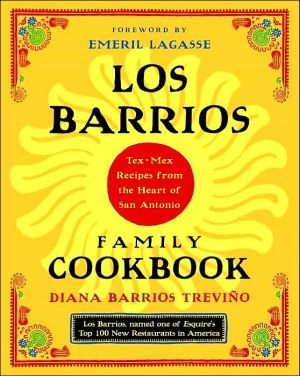Antojitos: Festive and Flavorful Mexican Appetizers
No one does antojitos (Mexican small plates)like Barbara Sibley and Margaritte Malfy, chef/owners of the fabulously popular La Palapa restaurants in Greenwich Village.\ In Antojitos, their first cookbook, Sibley and Malfy deliver addictively authentic Mexican fare–food for people who love fresh, soulful cooking. You’ll find 75 luscious small plates, scintillating salsas, and refreshing drinks–and a few perfect desserts. Get inspired by their classic Salsa Verde; crunchy, cheesy Chalupas con...
Search in google:
No one does antojitos (Mexican small plates)like Barbara Sibley and Margaritte Malfy, chef/owners of the fabulously popular La Palapa restaurants in Greenwich Village. In Antojitos, their first cookbook, Sibley and Malfy deliver addictively authentic Mexican fare–food for people who love fresh, soulful cooking. You’ll find 75 luscious small plates, scintillating salsas, and refreshing drinks–and a few perfect desserts. Get inspired by their classic Salsa Verde; crunchy, cheesy Chalupas con Chorizo; succulent Salmon Ceviche with Fresh Mango Salsa; earthy Crepas de Huitlacoche; spicy, ruby-red Hibiscus Margaritas with Piquín Chile Salt; silky, fragrant Kahlúa and Vanilla Flan; and many more. This is ideal party food, and Antojitos follows through with sidebars on Mexican cooking and entertaining, along with five suggested menus for themed parties: Año Nuevo (New Years), Cumpleaños (Birthday), Cinco de Mayo, Día de las Madres (Mother’s Day), and Día de los Muertos (Day of the Dead). Dozens of glorious food photographs round out the book. Authentic Mexican food has never looked so inviting, stylish, and fun.
Introduction\ \ As anyone who likes to cook can understand, when we sat down to write this cookbook, our first, we wanted to pack the pages with every recipe and bit of food lore we know as a way of sharing our passion for Mexican food and culture. But we quickly realized we had to rein in our eagerness–if not our enthusiasm–when choosing dishes to include. We finally decided to focus on the small bites, or antojitos, that Mexicans have been serving for centuries.\ At La Palapa, our two restaurants in Manhattan, our guests share our delight in genuine Mexican food and especially enjoy our antojitos. But it wasn’t until our fifth-anniversary fiesta that we realized that the most celebratory way to share our flavorful food was to create a savory meal composed solely of antojitos. We furiously cooked chalupas, quesadillas, taquitos, and more, and couldn’t get the platters out of the kitchen fast enough! Our guests raved about these small treasures, which helped set this book in motion.\ In Mexico, antojitos are sometimes eaten as appetizers before a meal, as they often are at La Palapa, but they are usually sold in small stalls in marketplaces or town plazas. Visit any outdoor Mexican market and you will immediately detect their heady aromas wafting through the air. Your senses will compete joyfully with one another–sight, hearing, smell, and touch–and beckon you to satisfy your fifth sense: taste. The word antojo means “craving,” which explains the name of these tasty, fresh bites.\ In some parts of Mexico, an antojito is called a tentempie, roughly, “a snack that keeps you standing”–in other words, a bite to tide you over until your next meal. These snacks are typically eaten out of hand or from a small paper cone or cup while standing or walking around. Although antojitos are not usually considered a full meal by Mexicans, they can be so bountiful and delectable that there is no reason not to add a margarita or a beer and declare an assortment of them a suitable supper.\ Every region in Mexico boasts its typical antojitos. Sometimes the same name is found in more than one region, although it refers to different foods. The opposite is also true. You may find that the antojito you sampled in Chiapas is called something quite different in Oaxaca or the Yucatán. No worries. Whatever they are called, they are invariably satisfying, and their long history, from the days of the Aztec markets to today’s plaza stalls, has ensured that each generation has added its own saz—n, or “seasoning,” by introducing a new salsa or a new filling or a new garnish.\ Perhaps what we like best about antojitos–beyond their sheer deliciousness–is that several served at one time can transform any gathering into a festive occasion. If you are planning a party, they are ideal. When we cater parties from our restaurant kitchen, we generally offer six or seven antojitos. But for a party at home, three or four will do. We have put together five fiesta menus for this book to demonstrate how to mix and match our antojitos for a party. Follow our suggestions and then go with your own ideas. You can’t go wrong.\ La Palapa is not your everyday Mexican restaurant. When you are seated in our Manhattan restaurants, your experience is far closer to dining in Mexico City than to eating in most “Mexican” restaurants in the United States. We pride ourselves on serving true Mexican food in all its complexity. Our recipes derive from Mexican home cooking, rather than restaurant cooking, and every dish is made with fresh, natural, authentic ingredients. Indeed, we are happiest when our guests from Mexico tell us our food “tastes like home.”\ Our recipes are traditional and artisanal, collected over many years of travel and living in Mexico. Our mole negro oaxaque–o (black mole from Oaxaca) calls for more than two dozen ingredients, and our salsas de mesa (table salsas) are carefully assembled with seasonal ingredients from Mexico. Purslane, nopal cactus, and huitlacoche inspire us, turning up in salads, tamales, and delicate crêpes, respectively. Even something typically as prosaic as totopos (tortilla chips) is special at La Palapa, where we make them from blue, yellow, and white tortillas and season them with cumin and sea salt. We have included recipes for these restaurant favorites and more in this book.\ Since opening La Palapa, we have traveled together extensively throughout Mexico, and with every trip we have expanded our knowledge of the country’s cooking. With this book on antojitos, we hope to pass along some of what we have learned about this complex and endlessly intriguing cuisine.\ La Palapa’s Fresh Lime Margarita (Margarita Cl‡sica de La Palapa)\ Several tales exist on the origin of the margarita, all of them dating to the 1940s. We like the story of Santos Cruz, a bartender in Galveston, Texas, who allegedly created the margarita for singer Peggy Lee, with the help of Margaret Sames, another Texan, who rimmed Miss Lee’s glass with salt. But the most credible account names Carlos “Danny” Herrara, owner of Rancho La Gloria restaurant in Tijuana, Mexico, who invented the drink for American actress Marjorie King. Herrara knew that King was allergic to all liquors except tequila, so he concocted a tequila and citrus cocktail and named it in her honor. -- Serves 1\ 1½ slices lime\ Kosher salt\ Ice cubes\ 2 ounces (¼ cup) Sour Mix (page 138)\ 2½ ounces (5 tablespoons) blanco tequila\ Scant 1 ounce (2 tablespoons) orange-flavored liqueur, such as triple sec or Cointreau\ ½ ounce (1 tablespoon) freshly squeezed orange juice\ Rub the rim of the glass with the whole lime slice. Use a 12-ounce glass for a margarita on the rocks; use a martini glass for a margarita straight up. Spread the salt on a small plate large enough for the rim of the glass, and dip the rim into the salt to coat. Set the glass aside.\ Fill a cocktail shaker or small pitcher with ice cubes. Add the sour mix, tequila, liqueur, and orange juice. Shake about 5 times, or until frothy and nicely chilled. Or, if using a pitcher, stir well with a long-handled wooden spoon.\ Fill the glass with ice cubes if serving on the rocks. Strain the margarita into the prepared glass. Slit the remaining ½ lime slice partway, balance the slice on the glass rim, and serve.
ContentsIntroduction \| viChapter 1 bebidas y botanasCocktails and Snacks \| 1Chapter 2 salsas de mesa Salsas for the Table \| 21Chapter 3 mariscos Seafood \| 39Chapter 4 aves Poultry \| 59Chapter 5 carnes Beef, Lamb, and Pork \| 81Chapter 6 de la hortaliza From the Vegetable Garden \| 103Chapter 7 el alma de la cocina: los básicosThe Soul of Mexican Cuisine: Basics \| 129Acknowledgments \| 147Index \| 148
